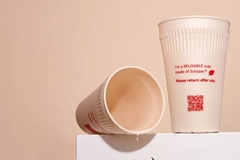Polytag and Pellenc ST merge tech to enhance packaging traceability and recovery
Pellenc ST has merged its advanced sorting technology with Polytag’s invisible UV watermark-based tracking to enhance packaging material recovery and traceability.
Pellenc ST specializes in the design and manufacturing of intelligent sorting and quality control solutions for the waste and recycling industry. Polytag is a data platform provider specializing in circular packaging information.
“This partnership enhances the real-time, barcode-level insights our UV watermarks provide. Now, in addition to tracing packaging to the point of recycling, MRFs can use these same tags for advanced sortation,” Alice Rackley, CEO at Polytag, tells Packaging Insights.
“This creates endless possibilities for sorting packaging — by material, food-grade, or non-food grade, color, transparency, or even by brand. This will lead to greater recycling efficiency and higher-quality recycled materials. With new legislation like EPR, PPWR, and Digital Product Passports (DPPs) pushing brands to own their waste, collaboration is key to making this happen.”
The companies say that combining Pellenc ST’s expertise in sensor-based sorting with Polytag’s data management can enable real-time tracking and optimization of packaging waste through the recycling process from MRF to Recyclers.
Polytag has implemented a sorting prototype in Pellenc ST Innovation Centre and validated it to TRL 7 (Technology Readiness Level 7 out of 9). Pellenc ST plans to manufacture UV reader modules.
“By combining our UV watermark technology, powered by GS1 standards, with their smart sorting and quality control solutions, we are giving brand owners unparalleled insight into their recycled packaging, reinforcing sustainability and traceability in the value chain.”
Jean Henin, CEO of Pellenc ST, adds: “Open standards are critical to implement Digital Product Passports. By partnering with Polytag, we are empowering recycling facilities with innovative tools to optimize sorting processes and enhance material recovery.”
NIR waste sorting
 When a pack with a UV watermark enters the recycling stream, a detection unit captures the data.The recycling process embeds packaging items with invisible printed UV watermarks, in the form of a GS1 open standard data matrices. When the packaging enters the recycling stream, a detection unit instantly captures the data contained in the UV watermark. The system can then sort the material based on near-infrared (NIR) spectroscopy.
When a pack with a UV watermark enters the recycling stream, a detection unit captures the data.The recycling process embeds packaging items with invisible printed UV watermarks, in the form of a GS1 open standard data matrices. When the packaging enters the recycling stream, a detection unit instantly captures the data contained in the UV watermark. The system can then sort the material based on near-infrared (NIR) spectroscopy.
“This technology is highly scalable. Crucially, these UV watermark tags require no changes to label artwork and integrate seamlessly into existing high-speed printing processes, as we’ve already demonstrated in live projects with Xact and Interket UK,” explains Rackley.
“We’ve also deployed a growing network of Polytag Detection Units (PDUs) across the UK, proving the reliability and practicality of large-scale implementation. Installed in MRFs, PDUs detect and record the tagged packaging as it enters the recycling stream.”
The non-exclusive partnership between Polytag and Pellenc ST can offer recycling facilities new capabilities to detect and sort waste streams.
Embedding smart data at the barcode level directly into packaging materials can boost waste management companies’ and brand owners’ control of their products’ “recycling journey” while ensuring that more packaging stays within the circular economy.
Last month, Polytag installed four Plastic Detection units at Material Recycling Facilities in Wales, UK, to track the 170,000 tons of annual waste entering the recycling and recovery stream.
Supporting DPPs with GS1 data
Rackley argues that regulations like DPPs are “fundamentally” reshaping how packaging is designed, consumed, and recycled, demanding levels of data transparency and accountability that brands cannot provide with “outdated, unstandardized data tracking.”
“For packaging traceability and circularity to take hold, the entire supply chain — from brands and retailers to MRFs and recyclers — needs to speak the same language. This is where GS1 open standards are indispensable.”
She adds that as DPPs transition from concept to reality, GS1 data matrices guarantee interoperability. “They provide a universally recognized framework that ensures standardization across diverse industries and geographies.”
“For Polytag, GS1 standards provide the bedrock for a working approach, ensuring that barcode-level data is actionable by all members of the supply chain, so responsibility can be taken for packaging waste. This makes our solution not just scalable but also future-proof and ready for widespread regulatory change.”











